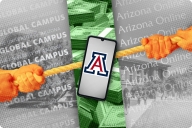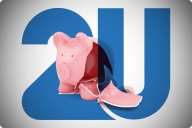You have /5 articles left.
Sign up for a free account or log in.
Lately, Arthur Kirk’s business wisdom has been a mash-up of topical and somewhat contradictory baseball analogies.
At a recent talk, Kirk, the president of Saint Leo University, invoked Moneyball -- the popular book-turned-film about how the impoverished Oakland Athletics built a winning baseball team -- to explain how non-elite universities would need to innovate in order to compete on relatively slim budgets. Showing some hometown pride, he swapped out the Athletics for the Tampa Bay Rays, who play their home games about 30 miles south of Saint Leo’s main campus. Kirk juxtaposed the Rays’ lean payroll ($42 million) with those of American League rivals the New York Yankees ($197 million) and the Boston Red Sox ($160 million). “My point was that it’s not about the resources, it’s about resourceful leadership,” he says.
On the phone with Inside Higher Ed last week, the morning after Tampa Bay edged out Boston for a playoff spot by beating New York in the final game of the regular season, Kirk reached for a different parallel. In 2008, Tampa Bay signed third baseman Evan Longoria to a nine-year, $44 million contract only a week after he had made his debut. Last week, Longoria hit a pair of dramatic home runs to win the clinching game. The Rays took an expensive risk investing in Longoria before they knew he could cut it in the big leagues, Kirk said. But sometimes a big investment pays off.
Pressed to explain how exactly that squares with the Moneyball ethic, Kirk admitted that it does not. He was just gloating.
Yet the contradiction highlights a problem familiar to many traditional universities: On the one hand, they want to compete in the global market of online higher education. But even before 2008, many lacked the cash or expertise to build an online infrastructure from scratch. As a result, some have ceded their online development and recruitment to outside companies. A cottage industry of online firms -- Bisk Education, Embanet-Compass, Deltak, 2tor, Colloquy and others -- has emerged to meet this need
Saint Leo was one of the first to do this, 14 years ago. Now it may be at the front edge of another trend -- that of universities that, having made the transition to online education, are dropping their for-profit partners and taking over themselves.
Making the Switch
In the late 1990s, Saint Leo -- a Roman Catholic liberal arts college with fewer than 1,000 students on its main campus and about 6,000 more, many of them active-duty military, attending classes at remote learning centers -- knew it had to go online in order to maintain its foothold among far-flung learners. Shortly after Kirk took office in 1997, Saint Leo entered a contract with Bisk Education, a for-profit provider, to help it expand on the Web. Bisk supplied instructional designers, tech support, lead-generation and recruiting services, marketing, and textbooks. In return, it got a cut of the university's online tuition revenue.
It was an unconventional move at the time. But by 2008, Saint Leo was a university with more than 14,000 students — not University-of-Phoenix big, but enough to be a “significant online player,” says Richard Garrett, managing director of the consulting firm Eduventures. Growing online also gave the university a previously unimaginable cash cushion: its tuition revenue leaped from $88,000 in 1997 to $56 million in 2009.
Kirk had played Moneyball and won. By hiring an outside contractor and making a hard online push while many of its nonprofit peers were still eyeing online learning from a distance, Saint Leo had found its footing on the new terrain of higher education using modest resources and an unconventional strategy.
Then in 2008, with online education and outsourcing on the rise among St. Leo's peers, Kirk did another unconventional thing: he dropped Bisk. In the three years since, Saint Leo has taken all the services it had originally ceded to for-profit contractors and brought them back under the university’s roof
Why? Put simply, Saint Leo had been doing it for long enough that the university felt it had sufficient know-how to cut the cord with Bisk. True, Bisk was essential in guiding the university for its first decade online, Kirk says. Crucially, the company had helped Saint Leo build the capital it needed to create its own online support infrastructure, which required a $9 million outlay. It also helped give the university breathing room to reinvest in its physical campus. Saint Leo broke ground last spring on two new residence halls. It has renovated old buildings and recently built a new softball field and batting cages. Last month it opened an $11 million brick-and-mortar business school equipped with state-of-the-art classroom technology. The building’s primary benefactor was Donald Tapia, a 2005 graduate of Saint Leo’s online M.B.A. program — who was apparently impressed enough with the experience to cut his alma mater a $4 million check, even though he never set foot on the physical campus until graduation.
But like many nonprofit universities, Saint Leo never preferred to outsource pieces of its operation to a for-profit. “The best partners, the best contractors, can really try to understand our values and commit to our values, but they have their own [values] too,” says Kirk. “So it’s never going to be 100 percent in sync.” Reincorporating Saint Leo’s online arm has produced palpable changes (if not measurable ones), says Kathryn McFarland, the vice president for enrollment and online services. Under Bisk, and then during a transitional period when Saint Leo contracted with the lead generator enCircle Media and the recruitment firm Greenwood & Hall, the for-profit collaborators were attentive but still, inevitably, apart from the university, McFarland says.
Now, “we have employees here who are fully part of the university,” she says. “They have opportunities to participate in the community and interact with faculty very closely…. I think there’s much more in-depth knowledge of the programs than we would ever have been able to do before.” McFarland adds that, while Saint Leo does not yet have enough data to compare student success under the old and new regimes, “anecdotal feedback from students has just been very positive since we’ve done it, and we’ve heard they have a really good understanding of all components of the university, and the components of success, before they get started.”
The Future of Outsourcing
What does the Saint Leo case say about the future of online outsourcing in higher education? Garrett, the Eduventures director, says Saint Leo is only the second university he knows of that has taken back full control of its online programs after initially outsourcing them. (The first was Regis University.) Since online contractors like Bisk require long-term deals, only the earliest adopters have been faced with the choice to either renew those contracts or take over the reins, says Garrett. (Some contracts can require a commitment of 10 years or more.)
But as universities that paid companies to hold their hands through the transition grow more comfortable with the “new normal” of running significant online programs, more might shrug off their for-profit partners, says Garrett.
“For schools for whom online becomes mainstream, [constituting] a significant portion of their total head count, then I think taking it in-house starts to feel logical,” he says. If running online programs has become a “core business,” then it makes sense for an institution to become self-reliant, Garrett says. Building the infrastructure might be expensive; but once it’s up and running, the university no longer has to share the revenue with anyone. For example, Saint Leo expects to save 10 to 13 percent on its recruitment costs in the long term by going it alone.
“I don’t think it's news to these companies that, at least to some of these clients, there’s a window of opportunity -- and that their very success in moving these institutions online might undermine it,” says Garrett.
“That’s one of the reasons they take a big upfront revenue cut and try to extend their contracts as long as they can,” says Paul LeBlanc, the president of Southern New Hampshire University.
LeBlanc understands that expanding online can be intimidating for an institution whose infrastructure and personnel are oriented to serving a small population of on-campus students. Southern New Hampshire has built a profitable 7,000-student online arm, aimed at older students, to help subsidize its traditional, 2,350-student physical campus -- which just added a new dining hall and Olympic-sized swimming pool.
For a traditional institution that serves traditional-age undergraduates on a small campus, the prospect of “scaling” online, and marketing to a new demographic of prospective student, raises a lot of questions, LeBlanc says.
For example, formulating a financial aid plan for an on-campus student typically is a “two-year conversation, “ he says. For an online student, the same conversation takes 48 hours. Most universities “don’t know what they don’t know” about making the transition, says LeBlanc.
“Partnering [with a company] can help answer those questions for you,” he says. “It can allow you to build competence over time with the idea that eventually you’ll be able to move out” of the partnership.
Rather than outsource to experts, LeBlanc decided instead to buy them. Southern New Hampshire has hired a number of people from the for-profit sector, most notably Steve Hodownes, the former president of Embanet. Hodownes now serves as Southern New Hampshire’s senior vice president of marketing and student recruiting. Saint Leo took a similar tack when it decided to part with its for-profit enrollment managers: it hired McFarland, its online services chief, from Kaplan.
Saint Leo hopes that its decision to assume full control over its online activities will prove as worthy of imitation as its original decision to outsource them. Kirk, the president, says he remains grateful to Bisk for helping Saint Leo get its bearings on the Web. And he concedes that taking full control of online programs might not be the right decision for everyone. (Several institutions have sought Saint Leo's counsel while reassessing their own partnerships, and none decided to follow Kirk's example, the president says.) But Kirk says his university is glad to have moved past what he describes as an inevitable tension built into partnerships between mission-driven universities and profit-driven companies.
“That value difference is always there,” Kirk says. “Sometimes you feel it and sometimes you don’t, but it’s always there.”
For the latest technology news and opinion from Inside Higher Ed, follow @IHEtech on Twitter.








